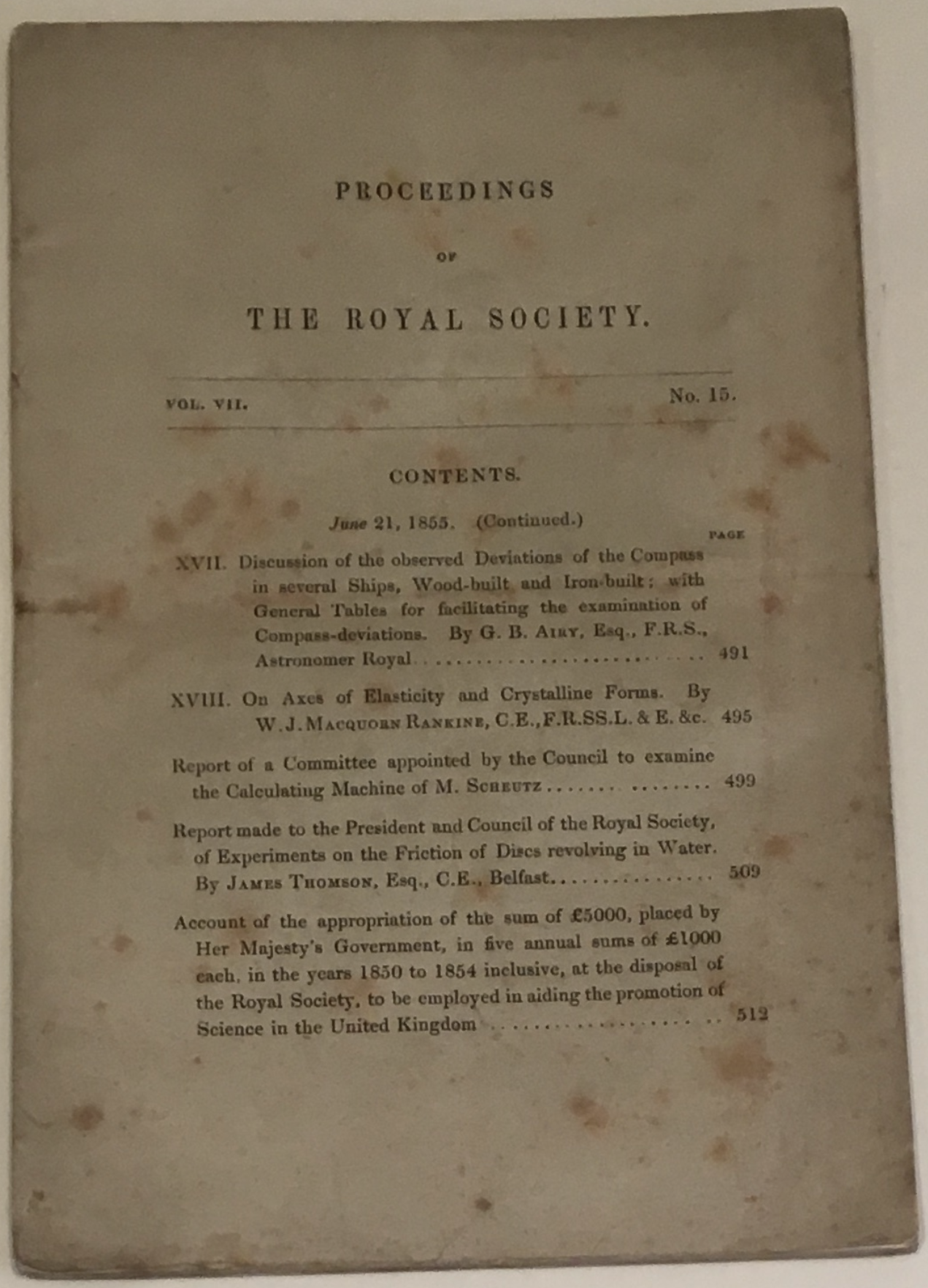Description
SCHEUTZ, Georg. Report of a Committee appointed by the Council to examine the Calculating Machine of M. Scheutz, pp. 499-509 in Proceedings of the Royal Society, vol. 7, no. 15, June 21, 1855.
First edition, complete journal issue in original printed wrappers.
“Inspired in 1834 by Babbage’s work, Georg Scheutz (1785-1873) a Swedish printer, publisher, journalist, translator and inventor, set about building a difference engine of his own. . . . Georg, and his son Edvard (1822-1881) completed a working prototype in 1843. The device was built in a wooden frame and made largely by Edvard, a teenager at the start of the project. It operated with three orders of difference (compared to seven for Babbage’s Difference Engine No. 2) and produced the first tables calculated and printed by machinery. Two expanded versions fully engineered in metal were produced, one in Stockholm in 1853, the other in London in 1859. The fully engineered Stockholm engine came to England in 1854 where it went on display at the Royal Society” (Computer History Museum).
“For some time in 1855 the machine was set up in the quarters of the Royal Society at Somerset House. There, too, a committee appointed by the Council of the Royal Society to examine the machine had opportunity to study it closely. The committee consisted of the newly elected secretary of the Royal Society, the mathematician and physicist G. G. Stokes (1819-1903), as chairman; the crystallographer W. H. Miller (1801-1880); the physicist and inventor C. Wheatstone (1802-1875); and R. Willis (1800-1875), inventor, architectural archeologist, and professor of mechanics. The committee prepared a report which described the basic problem of tabulating the values of functions, noting Babbage’s origination of the concept of a difference engine, and briefly mentioning the analytical engine, before proceeding to outline the operation of the Scheutz machine. The reportnoted that although Scheutz had adopted Babbage’s suggestion of operating oppositely on odd and even differences, so these could be handled simultaneously, the mechanism of the Scheutz machine is different from Babbage’s. The report concluded that the close tabulation of functions that the machine carries out is usually required only in table computation and that the Scheutz machine could be useful in that context. Noting that the standard logarithmic and trigonometric tables had been computed a long time ago, the committee suggested with appropriate caution that it might be worthwhile to construct other tables, “could it be done with the ease and cheapness as would be afforded by the use of the machine”. The report finally noted that the machine would prove worthwhile even in reprinting old tables, because it could “calculate and print more quickly than a good compositor could set the type, and that without risk of error”. Stokes added an individual postscript to the published version of the report, noting Babbage’s suggestion, which had been communicated to him in the meantime, of using his engine when the last differences are not constant” (Merzbach, Georg Scheuts and the First Printing Calculator, p. 19).
“The machine was sold for £1000 to the Dudley Observatory in Albany, New York where it arrived in 1857. It appears to have languished largely unused and is now at the Smithsonian Institution. The second engine was used as intended for the production of the 1864 English Life Table by the General Register Office in London. But its contribution was slight. The machine was temperamental, lacking as it did Babbage’s security devices, and hoped-for economies did not materialize. This machine is on display at the Science Museum in London” (Computer History Museum).
8vo, pp. 491-522. Original printed wrappers (foxed, light vertical crease).








